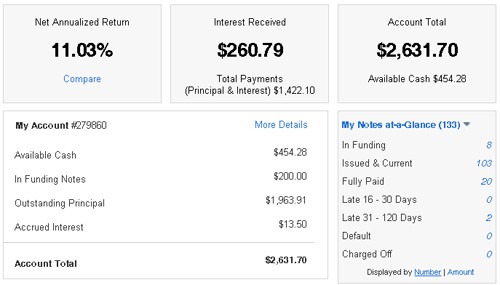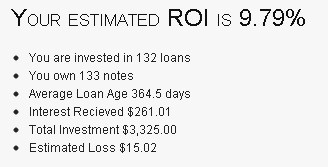Lending Club has been having another banner year, reaching a variety of milestones and being honored with several different awards, including the World Economic Forum 2012 Technology Pioneer. Among the recent milestones that they have achieved include last week when they reached $400 million in total loan originations, less than 4 months after they reached $300 million!
We’re proud to announce that this week Lending Club passed $400 million in total loan originations, less than four months after reaching $300 million. It’s hard to visualize such a large number, and we’ve had some fun kicking around ways to understand just how much money $400 million is—for example, it could buy 100 million gallons of gas (enough to drive from San Francisco to New York 1 million times!), 200 million Slurpees, or maybe 250 Lamborghini Reventons.
But in all seriousness, reaching $400 million is a big milestone for us, and an exciting way to move into the final months of what has been a tremendous year for Lending Club.
While Lending Club has been having a good year, the returns I’m seeing mean I’m continuing to have a good year as well. The returns are much better than anywhere else my money is currently. I’m seeing in excess of 11% returns when my stock market holdings are down, and savings accounts are yielding right around 1% in interest. I think Lending Club and social lending in general are a great way to diversify your savings and investments especially in such turbulent times.
Interested in my original Lending Club Review? check it out below.
Check out my original Lending Club review
Returns Now Up To 11.03%
My Lending Club investments have continued to improve, and they’ve now surpassed the 11% mark for the first time.
- Net Annualized Return of 11.03%: Up from 10.93% in September, 10.76% in August and 10.53% before that. That puts me in the 59th percentile. My returns are higher than 59% and lower than 41% of all investors.
- Number of defaults still zero… for now: Despite all odds I’m still showing zero defaults on my account, despite having given out over 100 loans so far. I’m actually surprised I haven’t had at least one or two. I do currently have two loans that are late, however. The funny thing is that the late loans are a Grade B and A loan, not one of the many lower grade ones I’ve signed up for. Go figure.
- Twenty loans have been paid off early: Nine were A grade loans, five were C grade loans, four were grade B and one grade E and F. Looks like grade A loans, while they’re more likely to be paid back, may also be more likely to pay of early – reducing returns. Another reason to look at including more higher grade loans.
- My account balance still going up: I currently have $2,631.70 in my account, with $454.28 of that ready to invest.
- I’m still diversified by investing across a large number of loans: I’ve got 133 loans, with no more than $25 in each loan. That way if I do have defaults, while my return may go down, my risk will be minimized. Lending Club noted earlier this month, that 100% of their investors who have invested 800 notes or more had positive returns. Not too shabby, not everyone in the stock market can say that!
So it looks like my strategy I laid out a while back of adding more risky C, D, E and F grade loans is paying off so far. My returns have gone up past 11% now!
How Do You Measure ROI?
One thing that is often talked about in the peer-to-peer lending world is how you can determine a more accurate way of knowing your true return on investment (ROI). Some have complained that the numbers on the Lending Club and Prosper sites will give an overly rosy view of what your actual or projected ROI will be, and the ways that they calculate your ROI are not standardized. They don’t take into account future default rates of your loans, how young or old your portfolio is, and other things that may be a factor. It’s basically a take or leave it when it comes to accepting their stated ROI on your portfolio.
This past month I read a great post over at SocialLending.net that talks about 5 ways to measure your ROI, and he expands on some alternative ways and tools that are out there for people to measure their own ROI. I normally just rely on what the Lending Club site tells me it is, although I know in reality it may be a bit lower. In checking my net annualized return this month on Lending Club, it sits at 11.03%.
One of the sites mentioned by Social Lending is Nickel Steamroller’s Lending Club portfolio analyzer. Basically the analysis tool with give you an estimated ROI after you download all your notes from your Lending Club account and upload the .csv file. It will go through you notes and give sell recommendations, show duplicate notes and highlight notes that are below Lending Club’s average return (so you can sell them on the secondary platform). In looking at my returns on the analyzer, my actual return according to the site will be closer to 9.79%.
I think my return is showing lower in part because I’ve currently got two loans 31-120 days late and a number of my loans are still relatively young. So we’ll see if this lower ROI bears itself out over time. I hope it’s higher though! I’ve gone a couple of years now with no defaults, I’m hoping I can continue that trend – but I wouldn’t count on it!
Lending Club Strategy
Here’s the basic strategy I’ve been using with Lending Club over the past couple of years.
- Less than $10,000: I believe I’ll still be sticking with mostly loans below $10,000. Lower amounts mean higher likelihood of payback of the loan.
- Zero delinquencies: Again, I may fudge slightly on this one, but I still want it to be very few or zero delinquencies.
- Debt to income ratio below 20-25%: I like to invest in loans where the borrowers have a lower DTI ratio, and preferably have higher incomes. I’ll try to keep this as is.
- Good employment history: I like loans with a decent employment history of at least 2 years, and a decent income.
So that’s what I’m doing with my Lending Club portfolio right now, and how I’m investing.
Not ready to invest, but looking to consolidate debt or pay off a high interest credit card? You might want to consider borrowing from Lending Club. Check out my post on borrowing from Lending Club.
Are you currently investing in Lending Club? How are your returns looking? Tell us in the comments!




Hi Peter,
I am using Lending Club now and really like it. I just cannot seem to get past selecting loans below “A” ratings….On Prosper I did, and lost several loans.
Looking on Nickle Steamroller—I see that “loans for Autos” seem to have the lowest defaults. Thanks for all the info. Brad
It’s funny you mention it – but the only loans I’ve ever had issues with on Lending Club are A and B loans. the lower grade loans have always paid. Maybe just luck of the draw, but I think as long as you’re properly diversified across a large number of loans, you’ll be OK, even with one or two defaults.
Auto loans are 4th for highest ROI. Debt consolidation loans are the best in terms of ROI. People in debt are already used to making periodic payments. My theory is they are well equipped psychologically to make monthly payments already. This theory applied to people who own their home would explain why people with no mortgage or rent actually have lower ROIs.
Well done Peter and thanks for the link to my article. It is very impressive that you have gone two years without a default. Fingers crossed those two late loans return to current for you. I think it was a smart move to start investing in the lower grade loans – they really do provide the best ROI. And as you can see with your account, A & B loans are not immune from going bad.